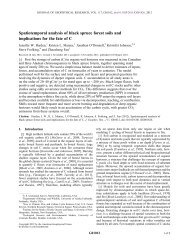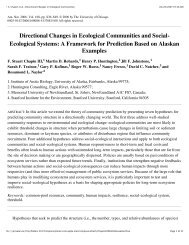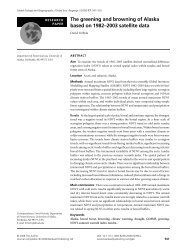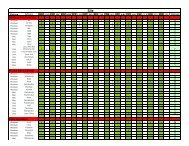Harden, J.W., S.E. Trumbore, B.J. Stocks, A. Hirsh, S.T. Gower, K.P. ...
Harden, J.W., S.E. Trumbore, B.J. Stocks, A. Hirsh, S.T. Gower, K.P. ...
Harden, J.W., S.E. Trumbore, B.J. Stocks, A. Hirsh, S.T. Gower, K.P. ...
- No tags were found...
Create successful ePaper yourself
Turn your PDF publications into a flip-book with our unique Google optimized e-Paper software.
F I R E I N T H E B O R E A L C A R B O N B U D G E T 181Fig. 3 The sensitivity of burn emissions to decomposition rateof charred remains (k char ) required to balance the C budget fordeep soil. Using a decomposition rate for deep soil ofk d = 0.0005 (turnover time of 2000 years; shown as lower linewith circles) to 0.0009 (1111 years; upper line with boxes) forblack spruce/feathermoss site, model results require a combinationof faster turnover time for charred material or higherburn emission to balance the C stored in deep soil. Shown ashorizontal lines, decomposition rates for char may lie somewherebetween ranges measured for k d and k s (Table 1).carbon as a result of increased heterotrophic respiration(O'Neill et al. 1997) and absence of vegetative cover. Asthe site recovers with new vegetation, dead and charredmaterial is protected by burial into deeper, colder layers(Goulden et al. 1998), and decomposition is offset by netprimary production. Based on the work of Rapalee et al.(1998), ®re scars are net C sources for about 30 years afterburning, after which time the systems become net sinksfor C. The loss of the insulating organic layers probablyalso has an effect on winter ¯uxes in which soils wouldbe colder to greater depths and may remain frozen for alonger period. However, the thickening of the activelayer after ®re suggests an overall warming. Althoughour model does not explicitly include a post-®rewarming or winter cooling, nor a slow transition duringregrowth, a sensitivity test suggested that a two-foldincrease in decomposition sustained for 20 years resultedin an underestimate of decomposition comparable toabout 3%NPP. This estimate, however, may change asdifferent model scenarios include changes in ®re returninterval and shifts in the C h and F terms.For a regional and global perspective on carbonexchange, carbon storage and decomposition may beextrapolated best by soil drainage class in associationwith ecosystem structure. For each drainage and ecosystemclass, we assigned relationships of C h , F, and NPP toareas of the globe based on the distribution of soildrainage and ecosystem class. Because the discontinuouspermafrost that underlies our study may disproportionatelyaffect ratios of F/(C h + F) relative to regionsFig. 4 A model of deep soil carbon storage (C d ) for wetland fensystems that burn very lightly, poorly drained spruce systemsthat burn severely, and well drained pine systems that decomposeand burn severely. The zig-zag pattern represents inputof dead and burned material from shallow to deep layers andsubsequent decline by decomposition between ®res. For a sitematuring after a burn, local Net Ecosystem Production (NEP)is represented by C accumulation in deep soil layers.Extrapolating NEP from local site measurements to a regionalscale or long-term average must include ®re emission lossesthat account for the major differences in carbon storage in fen,spruce and pine systems.lacking permafrost, the F/(C h + F) relationship may nothold true for the boreal forest in the absence ofpermafrost. Based on our areal extrapolations in thepresence of permafrost, however (Table 2), global boreal®re emissions could have been about 0.5±1 Pg C y ±1 overthe past century or millennia. This overlaps at least thelow end of some recent boreal ®re studies (Kasischkeet al. 1995a; Conard & Ivanova 1998) but is at least threetimes larger than extrapolations from some directemission estimates (Cahoon et al. 1994) and 3±10 timeslarger than estimates used in general circulation models(Houghton 1991; Randerson et al. 1997; Wittenburg et al.1998; see discussion below). While our estimates arehighly uncertain, they do emphasize the importance of®re emissions in closing the C budget over century-tomillenialtimescales, and they emphasize the linksbetween NPP, decomposition and ®re.DiscussionIf the distribution of stand age were to change through®re suppression or through changes in climate, then therelationships of NPP, k, C, and F would change and# 2000 Blackwell Science Ltd, Global Change Biology, 6 (Suppl. 1), 174±184







